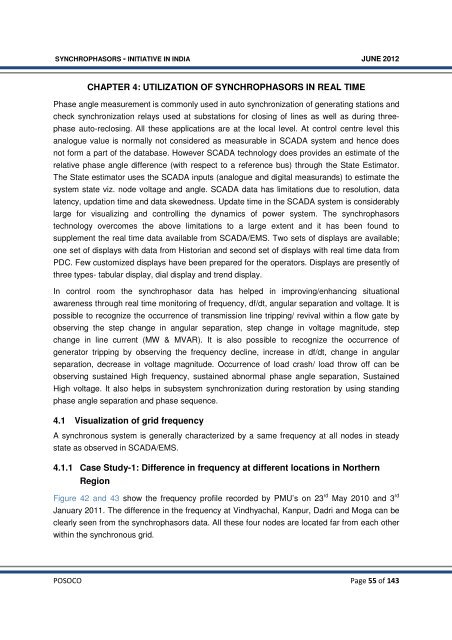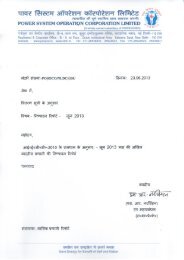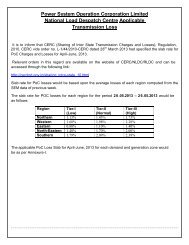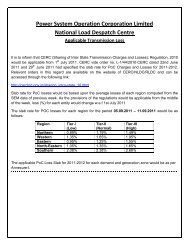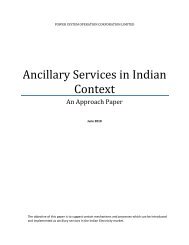Synchrophasor Initiative in India - erldc
Synchrophasor Initiative in India - erldc
Synchrophasor Initiative in India - erldc
Create successful ePaper yourself
Turn your PDF publications into a flip-book with our unique Google optimized e-Paper software.
SYNCHROPHASORS - INITIATIVE IN INDIA JUNE 20124 CHAPTER 4: UTILIZATION OF SYNCHROPHASORS IN REAL TIMEPhase angle measurement is commonly used <strong>in</strong> auto synchronization of generat<strong>in</strong>g stations andcheck synchronization relays used at substations for clos<strong>in</strong>g of l<strong>in</strong>es as well as dur<strong>in</strong>g threephaseauto-reclos<strong>in</strong>g. All these applications are at the local level. At control centre level thisanalogue value is normally not considered as measurable <strong>in</strong> SCADA system and hence doesnot form a part of the database. However SCADA technology does provides an estimate of therelative phase angle difference (with respect to a reference bus) through the State Estimator.The State estimator uses the SCADA <strong>in</strong>puts (analogue and digital measurands) to estimate thesystem state viz. node voltage and angle. SCADA data has limitations due to resolution, datalatency, updation time and data skewedness. Update time <strong>in</strong> the SCADA system is considerablylarge for visualiz<strong>in</strong>g and controll<strong>in</strong>g the dynamics of power system. The synchrophasorstechnology overcomes the above limitations to a large extent and it has been found tosupplement the real time data available from SCADA/EMS. Two sets of displays are available;one set of displays with data from Historian and second set of displays with real time data fromPDC. Few customized displays have been prepared for the operators. Displays are presently ofthree types- tabular display, dial display and trend display.In control room the synchrophasor data has helped <strong>in</strong> improv<strong>in</strong>g/enhanc<strong>in</strong>g situationalawareness through real time monitor<strong>in</strong>g of frequency, df/dt, angular separation and voltage. It ispossible to recognize the occurrence of transmission l<strong>in</strong>e tripp<strong>in</strong>g/ revival with<strong>in</strong> a flow gate byobserv<strong>in</strong>g the step change <strong>in</strong> angular separation, step change <strong>in</strong> voltage magnitude, stepchange <strong>in</strong> l<strong>in</strong>e current (MW & MVAR). It is also possible to recognize the occurrence ofgenerator tripp<strong>in</strong>g by observ<strong>in</strong>g the frequency decl<strong>in</strong>e, <strong>in</strong>crease <strong>in</strong> df/dt, change <strong>in</strong> angularseparation, decrease <strong>in</strong> voltage magnitude. Occurrence of load crash/ load throw off can beobserv<strong>in</strong>g susta<strong>in</strong>ed High frequency, susta<strong>in</strong>ed abnormal phase angle separation, Susta<strong>in</strong>edHigh voltage. It also helps <strong>in</strong> subsystem synchronization dur<strong>in</strong>g restoration by us<strong>in</strong>g stand<strong>in</strong>gphase angle separation and phase sequence.4.1 Visualization of grid frequencyA synchronous system is generally characterized by a same frequency at all nodes <strong>in</strong> steadystate as observed <strong>in</strong> SCADA/EMS.4.1.1 Case Study-1: Difference <strong>in</strong> frequency at different locations <strong>in</strong> NorthernRegionFigure 42 and 43 show the frequency profile recorded by PMU’s on 23 rd May 2010 and 3 rdJanuary 2011. The difference <strong>in</strong> the frequency at V<strong>in</strong>dhyachal, Kanpur, Dadri and Moga can beclearly seen from the synchrophasors data. All these four nodes are located far from each otherwith<strong>in</strong> the synchronous grid.POSOCO Page 55 of 143


